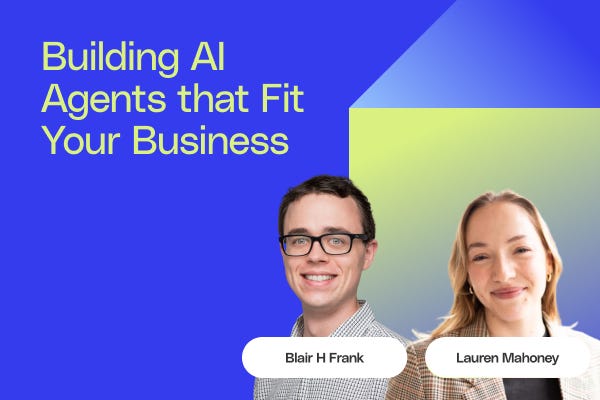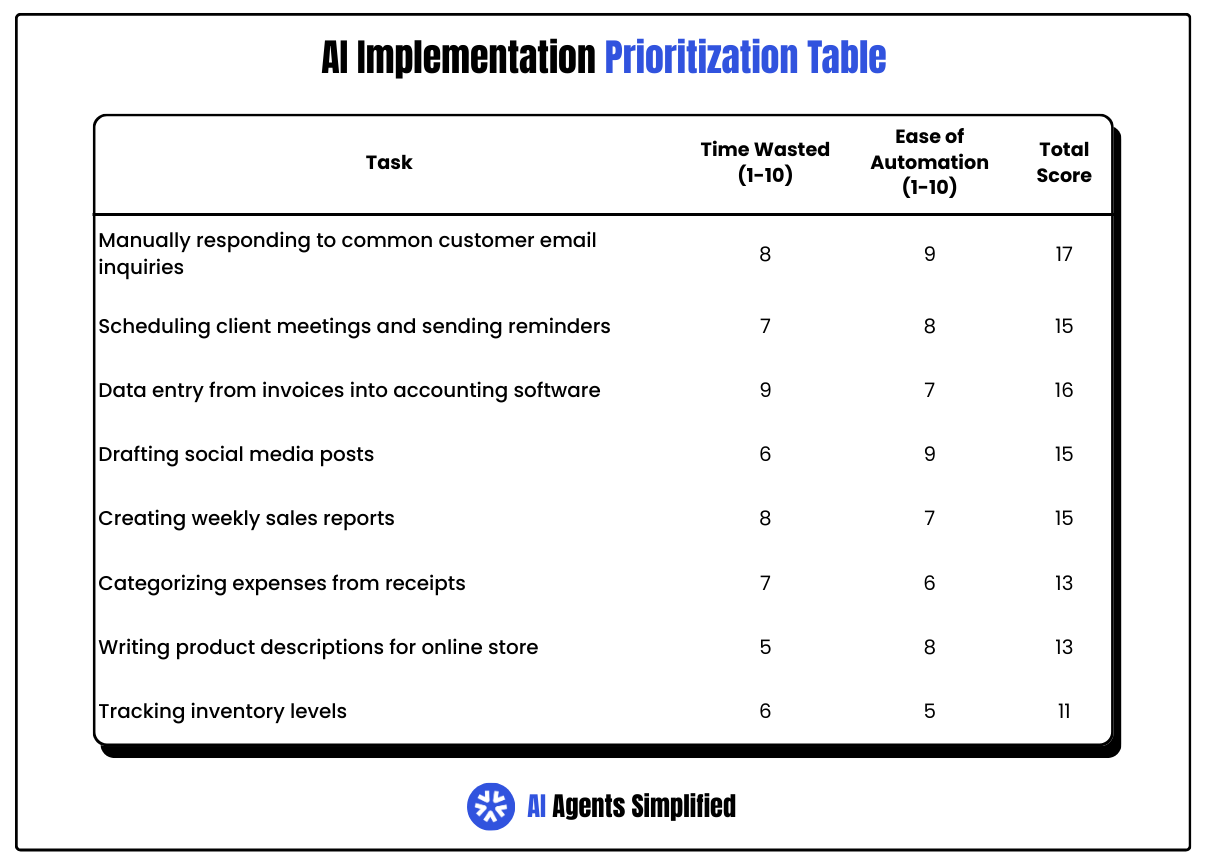#21 - The 15-Minute AI Audit Every Small Business Should Do Right Now (Part 1)
Find exactly where AI can save you time before spending a dime on tools
Welcome to 21th issue of AI Agents Simplified. This issue is presented to you by Glean
Your competitor down the street isn't hiring more staff to handle their growing business, they're spending $50 a month on AI tools that do the work of three employees. And they're not alone.
In a few short years, Gen AI has upended entire industries and rendered them obsolete. ChatGPT was just the start.
Now, corporations are using AI agents to automate much of their core operations, from customer service to content creation. Soon, the amount of work that used to be done by a team of people will be done by one knowledgeable strategist and a few bots and agents.
It’s big, scary stuff. The full effects of AI are still ahead of us. No one is truly prepared, not even the people building this technology.
But there is good news - AI is not that hard!
Beneath hype, the catastrophic “AI will take your job” narratives, the alarmist rhetoric, and the doom-and-gloom you see on social media, there is real, untapped opportunity for those who can leverage this technology to solve business problems.
You don’t need to be a tech giant with deep pockets to make AI work for you. These tools are accessible to anyone, even businesses with fewer than 50 employees - and they can make your business work better and more efficiently than ever.
Small businesses can now use the same AI capabilities as corporations without massive budgets - many of these tools have free plans and cost no more than $20 per month for the “upgraded” versions.
Many small businesses are already doing it.
A boutique clothing store implemented an AI-driven inventory tool to optimize ordering, reducing excess inventory by 28% and out-of-stock situations by 35%.
A local law firm used AI tools to schedule client appointments 50% faster, draft routine legal docs 3× quicker, and research cases 20% more efficiently.
A bakery implemented a ChatGPT-powered customer service bot for about $5k and saw an estimated $15k annual savings in reduced workload.
These aren't hypothetical scenarios - these are real businesses just like yours. AI was a game changer for them, and it can be for you too.
This article will offer you a roadmap for identifying, implementing and measuring AI solutions that you can start putting in place today - backed by practical, real-world advice from experts who consult with businesses daily on AI implementation.
Off-load your tasks with AI agents that work, at work.
Learn to build AI agents that fit your needs with the help of experts at the forefront of Work AI.
This on-demand webinar gives you step-by-step guidance for building AI agents that deliver real, scalable impact in your day-to-day work. Don’t miss out on your chance to see live demos of agents that drive measurable ROI and speed up workflow completion by up to 97%.
The 15-Minute AI Opportunity Audit
Many businesses, especially in corporate settings, make the mistake of embracing AI innovation first, then figuring out ways to use it. Leadership often gets caught up in the hype and excitement of AI innovation, and adopts the technology prematurely for the sake of chasing trends.
If anything, it should be the other way around. The far more effective approach is to be clear on what the main bottlenecks and inefficiencies in your business are, then be intentional on how you plan to use AI to help solve them. Identify the problems first, tools second.
Before rolling out any AI solutions, spend 15 minutes auditing your routine workflows and processes, and pinpoint the tasks which take the most time but produce the least results.
Christine Orchard, Host of Marketers Do Coffee, recently did an AI audit for her own podcast, and started seeing results with just a few small automations:
“Pull up your last project in Airtable/Excel/Google Sheets, highlight every step that feels like copy-paste, then time how long each one takes,” Christine says.
“I did this with my podcast workflow and saw lots of copy/paste between ChatGPT manually by hand. A few Zapier zaps now create drafts from source content at different stages of the workflow down streem, saving roughly 4 hours per week. You should be thinking about spending more time in your zone of genius and less time "doing tasks" that workflows and AI agents can help with today.”
Taking 15 minutes to assess your current workflows can help you map out the major problem areas, pinpoint the low-hanging fruit, and find the best opportunities where AI can make the biggest impact in your business. Here’s a stimple, step-by-step audit you can follow:
Step 1: List Your Core Processes
Write down 5-10 tasks that you do every day to run your business. These might be tasks like:
Answering customer service emails
Bookkeeping, and categorizing your transactions
Drafting your SoPs or work proposals
Marketing content creation
Ecommerce order fulfillment
Talk to your team and involve them in the conversation. Your employees are likely to know the really frustrating bottlenecks. Ask them what they are: “What parts of doing their job are taking up their time and distracting them from doing meaningful work that matters?”
Step 2: Spot Repetitive Time-Wasters
Once you’ve mapped out your core business operations, break down the tasks that fall under each process, and identify the ones that are repetitive or time-consuming.
Think of it as a friction log, an account of the most time-consuming, lowest value tasks that can be removed and eliminated for quick, easy productivity gains. For example, if your staff spend hours every week manually replying to FAQ emails or updating spreadsheets, mark those down.
A good rule of thumb is to ask yourself: “If I could have an assistant take care of this for me so that I would never have to worry or even think about it again, what would it be”? Use AI to automate that first.
Common candidates include:
Data entry
Scheduling appointments
Generating routine reports
Copying information between spreadsheets or documents
These are likely your AI opportunities, the areas where AI can have the most impact with the least effort.
Step 3: Evaluate AI Potential
For each of the tedious, repetitive, low-value tasks you listed out, now is the time to determine whether an AI or automation tool can do it for you. Go down the list, and ask yourself:
"Could a smart robot answer this question for me?"
"Is this task just following the same steps every time?"
"Am I copying information from one place to another?"
"Do I use a template or formula to do this?"
If you answered "yes" to any question, mark that task for potential AI implementation.
You don’t need to know the exact answers yet. At this stage, you’re just exploring the possibilities, and finding the areas where AI could potentially help.
Can a chatbot answer those FAQs? Can an LLM (like ChatGPT or Claude) draft those emails or social posts? Maybe an integration with Zapier, Make.com, or n8n can move data between your spreadsheets more easily. Jot down ideas next to each task.
Step 4: Prioritize Quick Wins
At this point you should have a clear idea of what areas of your business AI can potentially help with the most. Now it’s time to make a plan for which of those can be safely automated or eliminated for immediate, low-risk productivity gains, or “quick wins.”
A quick win should be relatively easy to automate, and save you a significant amount of time and energy. For example, generating customer email responses might immediately save you 5 hours per week, while using AI to do sales forecasts might be trickier and more involved.
Focus on one or two high-value, low-complexity tasks as your starting point. Sit down and make a simple table with two columns:
Column 1: "How much time does this waste?" (1-10)
Column 2: "How easy would this be to automate?" (1-10)
Let’s look at an example:
How to use this table:
Score each task from 1-10 on how much time it wastes (10 = massive time sink)
Score each task from 1-10 on how easy it would be to automate (10 = very easy)
Add the scores together to get a total
Tasks with the highest total scores should be your first AI implementation targets
In this example, "Responding to common customer email inquiries" has the highest score (17), making it an ideal first candidate for AI automation - it wastes significant time and is relatively straightforward to automate with current AI tools.
Lisa Kanda, an AI consultant and marketing strategist, guides small businesses through their AI transformation. She points to three major roadblocks she often sees in AI adoption: relevance gaps, overwhelm, and fear, all of which are interconnected.
1. Relevance Gap - Many business owners simply don't see how AI applies to their specific industry or daily challenges. They hear about AI in abstract terms but can't connect it to solving real problems.
2. Information Overwhelm - The sheer volume of AI content—articles, videos, tools, and opinions creates analysis paralysis.
3. Fears - There is worry about AI replacing employees or making their own skills obsolete as well as concerns about data security, hallucinations and accuracy.
“To overcome these, I first enter the discovery phase where I determine their current knowledge level and specific business pain points,” says Lisa. “It's a baby step approach so I do not overwhelm them with AI's possibilities. The goal is to identify one small, low-risk application that can show immediate value. It's important to make the application relevant to their business. I'll demonstrate AI using their actual business scenarios—their customer emails, their social media, their real challenges”
First Theory, Then Action
After a quick 15-minute audit, you should have a clear view of the parts of running your business where AI can have the highest impact. Next week, we’ll cover how you can put those plans into action and get tangible, measurable results from AI implementation in Five Low-Risk, High-Return AI Use Cases. Take 15 minutes to do the opportunity audit, and after next week you’ll know exactly how to turn your findings into AI transformations into better productivity and reclaimed time.








This is such a practical approach! Most small businesses rush into AI tools without a clear plan, but this 15-minute audit flips that logic, identify problems first, then pick the right AI solutions.
Can you make any changes to AI in industrial applications?